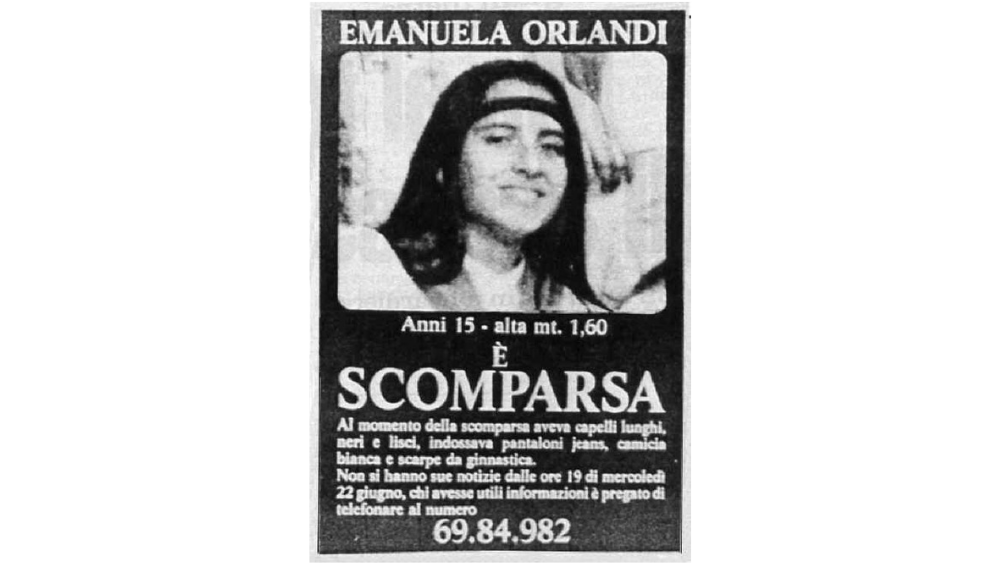The Vatican City State Tribunal has agreed to open two medieval tombs at the request of the family of Emanuela Orlandi, who disappeared in 1983.
The two tombs are located in a tiny cemetery in the centuries old Teutonic Cemetery. They are due to be opened on July 11, with representatives of the family of Emanuela Orlandi present, after the family received an anonymous, cryptic tip that she might be buried there.
The tip came in the form of a letter and was received by the family’s lawyer, Laura Sgro in March. Enclosed was a photo of an angel sculpture above a tomb in the Vatican’s Teutonic Cemetery. “Look where the angel is pointing,” said the letter.
Sgro filed a formal petition with the Vatican to investigate the matter and possibly open the tombs in question. Last week, the Vatican agreed to have the tombs opened and the contents exhumed for DNA testing.
Emanuela Orlandi was fifteen years of age when she mysteriously disappeared on 22 June 1983 after attending a flute lesson in Rome. On the way to the flute lesson, a man in a green BMW stopped her on the street and offered her money to sell Avon cosmetics. Orlandi called her sister to discuss the offer, who told her to speak to their parents about it.
What happened next is unclear but has been the subject of complex and wild reports in the Italian media – none of which have provided answers about what happened to the young woman.
Just last year, when workers were renovating an annex of the Vatican’s embassy to Italy in Rome and bones were found, Italian media again went into a frenzy wondering whether they might provide answers to the country’s hottest cold case. DNA testing was negative.
In the days following the first media reports of her disappearance, two different men contacted her family claiming to have seen someone matching her description playing the flute, going by the name of Barbara and selling cosmetics.
On July 3, 1983 Pope John Paul II made a public appeal for her safe return after a public prayer, saying “I am close to the Orlandi family.” Two days later, the family and Vatican were contacted with advice saying she had been kidnapped to secure the release of Turkish Mehmet Ali Agca, who had attempted to assassinate the Pope in 1981.
Code-named ‘L’Americano’ by Italian authorities due to his American accent, the man reportedly led detectives to a photocopy of Emanuela’s registration card for her music school, and sent them copies of the sheet music she had been studying. However his contact with authorities ended on October 27, 1983.
Other terrorist groups wrote similar letters, saying the teenager would be released upon Agca’s release. No exchange eventuated and Agca was released after being pardoned from his life sentence in 2006.
In 2008, the former mistress of a gangster named Enrico De Pedis informed Italian authorities that De Pedris had organised Orlandi’s kidnapping at the behest of the controversial American archbishop, Paul C. Marcinkus. Marcinkus was the former president of the Vatican Bank and he died in 2006 and some suggested that Orlandi’s father, a clerk, had evidence of Marcinkus’ wrongdoings.
After seven years of refusing, the Vatican agreed to open De Pedis tomb, located in the Roman Basilica of Sant’Apollinaire – another controversy, because De Pedis’ burial had been approved in a site usually reserved for the burial of senior clerics. The tomb was opened in 2012 in the hope of finding Orlandi’s remains but nothing was found.
In a 2017 report by journalist Emiliano Fittipaldi, a five-page, typed document was published which had allegedly been stolen from a cabinet inside the Vatican. It asserted Holy See officials may have been directly involved in Orlandi’s disappearance, who may have been paying for expenses since then, and that she might still be alive. The Vatican said that the document was “false and ridiculous.”
Just last year, when workers were renovating an annex of the Vatican’s embassy to Italy in Rome and bones were found, Italian media again went into a frenzy wondering whether they might provide answers to the country’s hottest cold case. DNA testing was negative.
After the Teutonic Cemetery tomb is opened on Thursday, remains in the tombs will be inventoried and catalogued, then tested to determine the age of the remains and their DNA.
If alive, Emanuela Orlandi would now be 51 years of age.
Email This Story
Why not send this to a friend?


